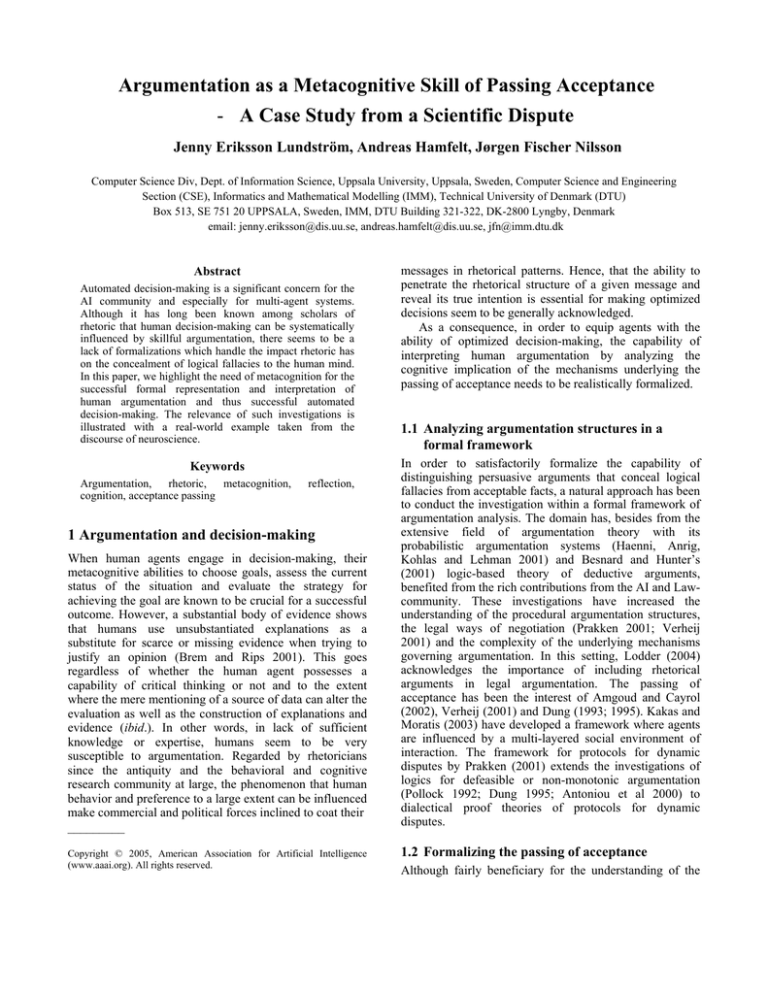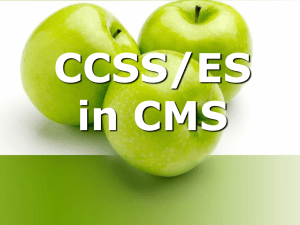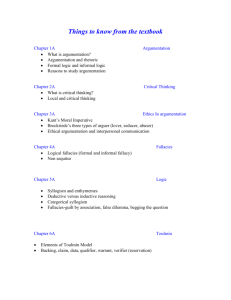
Argumentation as a Metacognitive Skill of Passing Acceptance
- A Case Study from a Scientific Dispute
Jenny Eriksson Lundström, Andreas Hamfelt, Jørgen Fischer Nilsson
Computer Science Div, Dept. of Information Science, Uppsala University, Uppsala, Sweden, Computer Science and Engineering
Section (CSE), Informatics and Mathematical Modelling (IMM), Technical University of Denmark (DTU)
Box 513, SE 751 20 UPPSALA, Sweden, IMM, DTU Building 321-322, DK-2800 Lyngby, Denmark
email: jenny.eriksson@dis.uu.se, andreas.hamfelt@dis.uu.se, jfn@imm.dtu.dk
Abstract
Automated decision-making is a significant concern for the
AI community and especially for multi-agent systems.
Although it has long been known among scholars of
rhetoric that human decision-making can be systematically
influenced by skillful argumentation, there seems to be a
lack of formalizations which handle the impact rhetoric has
on the concealment of logical fallacies to the human mind.
In this paper, we highlight the need of metacognition for the
successful formal representation and interpretation of
human argumentation and thus successful automated
decision-making. The relevance of such investigations is
illustrated with a real-world example taken from the
discourse of neuroscience.
Keywords
Argumentation,
rhetoric,
metacognition,
cognition, acceptance passing
reflection,
1 Argumentation and decision-making
When human agents engage in decision-making, their
metacognitive abilities to choose goals, assess the current
status of the situation and evaluate the strategy for
achieving the goal are known to be crucial for a successful
outcome. However, a substantial body of evidence shows
that humans use unsubstantiated explanations as a
substitute for scarce or missing evidence when trying to
justify an opinion (Brem and Rips 2001). This goes
regardless of whether the human agent possesses a
capability of critical thinking or not and to the extent
where the mere mentioning of a source of data can alter the
evaluation as well as the construction of explanations and
evidence (ibid.). In other words, in lack of sufficient
knowledge or expertise, humans seem to be very
susceptible to argumentation. Regarded by rhetoricians
since the antiquity and the behavioral and cognitive
research community at large, the phenomenon that human
behavior and preference to a large extent can be influenced
make commercial and political forces inclined to coat their
_________
Copyright © 2005, American Association for Artificial Intelligence
(www.aaai.org). All rights reserved.
messages in rhetorical patterns. Hence, that the ability to
penetrate the rhetorical structure of a given message and
reveal its true intention is essential for making optimized
decisions seem to be generally acknowledged.
As a consequence, in order to equip agents with the
ability of optimized decision-making, the capability of
interpreting human argumentation by analyzing the
cognitive implication of the mechanisms underlying the
passing of acceptance needs to be realistically formalized.
1.1 Analyzing argumentation structures in a
formal framework
In order to satisfactorily formalize the capability of
distinguishing persuasive arguments that conceal logical
fallacies from acceptable facts, a natural approach has been
to conduct the investigation within a formal framework of
argumentation analysis. The domain has, besides from the
extensive field of argumentation theory with its
probabilistic argumentation systems (Haenni, Anrig,
Kohlas and Lehman 2001) and Besnard and Hunter’s
(2001) logic-based theory of deductive arguments,
benefited from the rich contributions from the AI and Lawcommunity. These investigations have increased the
understanding of the procedural argumentation structures,
the legal ways of negotiation (Prakken 2001; Verheij
2001) and the complexity of the underlying mechanisms
governing argumentation. In this setting, Lodder (2004)
acknowledges the importance of including rhetorical
arguments in legal argumentation. The passing of
acceptance has been the interest of Amgoud and Cayrol
(2002), Verheij (2001) and Dung (1993; 1995). Kakas and
Moratis (2003) have developed a framework where agents
are influenced by a multi-layered social environment of
interaction. The framework for protocols for dynamic
disputes by Prakken (2001) extends the investigations of
logics for defeasible or non-monotonic argumentation
(Pollock 1992; Dung 1995; Antoniou et al 2000) to
dialectical proof theories of protocols for dynamic
disputes.
1.2 Formalizing the passing of acceptance
Although fairly beneficiary for the understanding of the
acceptance structures of the particular domain, most
representations emphasize the dialectical proof theories for
logics of protocols for dynamic disputes. The focus of
interest is laid on modeling the reasoning as an
argumentative dialogue system, where argumentation has
been viewed as a verbal game to be lost or won. The
formalizations are built on notions like “defeat”, “attack”,
“assumptions” and the like. Unfortunately, very little
emphasis has in this setting been given to formalizations of
a more comprehensive view of justification and acceptance
in general and capturing the cognitive effect rhetoric has
on the human mind and the mechanisms underlying the
passing of acceptance of a given message in particular.
The inherent problem with this absence becomes clear
when encountering a situation in which a layman examines
presentations covering the same information but with
different underlying rhetorical structures and thus different
intended messages. The lack of sufficient disclosure of
these structures and agendas results in an illusory
objectivity of the presented material, which together with
the human predisposition of relying to heavily on
explanations, facilitates the passing of acceptance of the
standpoint. As a consequence the very base of decisionmaking becomes flawed.
In this paper we attempt to draw attention to the
importance of including a metacognitive model for
examining information structures in improving the realism
of automated decision-making on incomplete information.
The paper is organized as follows. Section 2 reviews
rational argumentation. In section 3, a case study from
contemporary neuroscience is presented. It highlights the
need for a formalization of acceptance passing from the
perspective of cognitive impact. Section 4 elaborates on
the considerations of a cognitively more realistic
argumentation analysis. Section 5 describes the
metacognitive feature needed for the argumentation
analysis discussed in section 4. Finally, section 6 and 7
hold conclusions and perspectives on the presented
approach.
2 Rational argumentation
Rational argumentation is “[…] a verbal and social activity
of reason aimed at increasing (or decreasing) the
acceptability of a controversial standpoint for the listener
or reader, by putting forward a constellation of
propositions intended to justify (or refute) the standpoint
before a rational judge.” (van Eemeren, Grootendorst and
Henkemans 1996, p.5).
An argumentation starts out from a point where
everything in the argumentative discourse, i.e. the
premises, implicit assumptions and the following
arguments are judged for accuracy, relevance, plausibility
and level of endorsement of their respective functional
status for a particular standpoint. The structures of each
argument are judged for appropriateness and adequacy and
the underlying argumentation schemes are evaluated for
suitability and correctness of application. The ability to
reflect on the arguments put forward during
communication and information distribution is essential for
the construction of arguments and successful passing of
acceptance of a debated standpoint (van Eemeren et. al
1996p5). Thus, successful human argumentation is based
on our metacognitive abilities and our capabilities of
reflection.
However, when performing the evaluation of the
acceptability of the standpoint it has been claimed that
human agents do not attach the meaning of an utterance to
the truth conditions of the utterance. Instead its inherent
meaning lies in the way that it changes the information
status of the interpreter (Groenendijk and Stokhof 1991).
Furthermore, the analysis of what actually transfers the
acceptance is even more complex considering that in the
communication itself humans rely on the reflexive
intention of the communication being perceived as such
(Grice 1989) and also possess some methods for
attributing mental states of others. Hence, the utterer’s
perception of the audience’s knowledge and capabilities of
evaluating the utterance is a source of influence on the
strategy and construction of argumentation (compare to the
new rhetoric of Perelman and Olbrechts-Tyteca. For a
comprehensive study see van Eemeren et al 1996).
To understand the functionality of an argument in
achieving the aim of acceptance passing, we seem to need
a formalization that handles the cognitive effect of an
argument and not the argument itself. This undertaking
requires not only representation of cognitive knowledge
but also a representation of the awareness of the own
cognitive knowledge and processes. Moreover, in order to
make a realistic evaluation of the dialectical situation, this
feature should be able to reflect on the mental state of the
arguer and the intended audience. In other words, it
requires a representation able to handle cognitive impact as
well as cognitive responsiveness to other’s thinking
processes.
3 A case study
Depression is a disease that has long withstanding and
crippling effect on the sufferer and his or her environment.
The cause of depression is unclear, although many
neuroscientists blame an imbalance of brain chemicals, the
so-called neurotransmitters. However, now a new, radical
but complementary theory has come up: That depression is
the result of a shrunken brain, i.e. lack or slowdown in
brain cell growth. This issue has been the focus of debate
for some time and resulted in articles in various
newspapers and journals. Here the situation under dispute
from the discourse of neuroscience is reviewed as far as
relevant for the purpose of this paper. The case study is
based on the articles of Vogel (2004) “New Brain Cells
Prompt New Theory of Depression”, Science 290, pp 258259, here referred to as the Science-article and Frank
(2004) “Hjerne på skrump”, (Danish for “Shrunken brain”
our translation), WeekendAvisen, 14-15/5-2004, below the
WA-article.
In the present analysis, we put the focus of interest on
the WA-article and the utilized mechanisms of passing of
acceptance of the superiority of one of the theories. Thus,
in our analysis, the supremacy of this theory, claimed in
the WA-article is the standpoint (thesis) of investigation.
The standpoint will be referred to as ∆. The
complementary theory supporting the imbalance of
neurotransmitters will be referred to as Φ.
3.1 The arguments
The arguments put forward are basically the same in both
the Science and the WA-article. The following main
arguments are introduced:
α - The hippocampus of depressed people were 15%
smaller than that of normal people
β - The frontal part of the brain is also shrunken in
depressed people
γ - Amygdala was significantly enlarged within many of
the depressed
δ - Increased resemblance between the symptoms of
shrunken brain and symptoms of Alzheimer and
Parkinson’s diseases
ϕ - Depression is the result of low serotonine levels in the
brain (monoamine theory)
φ - A second group of researchers from Yale University
has discovered that antidepressants stimulates BDNF,
which keeps the cells of the brain alive
ω - Antidepressants only give results on about half of the
mildly depressed people
3.2 Analyzing the argumentation
Viewed from a dialectical perspective, the different
arguments for and against the new theory, are according to
the Science-article indecisive, can be seen as highly
speculative but with some interesting observations in favor
of its case. However, from the presentation in the WAarticle, which at the first glance contains the same
information as the previous article, due to the
argumentation structure and the goal of persuading the
reader of the correctness of the new theory, the story
appears clear-cut.
In the WA-article, all arguments are directly or
indirectly utilized as evidence for the taken standpoint ∆.
The counterargument ϕ is placed in the arrangement of the
argumentation to make the least damage to ∆. By the way
ϕ is presented, in which the objection ϕ poses is weakened
and finally defeated by arguments like ω and φ,
surprisingly the counterargument is transformed into a
support for the main claim ∆. Hence, there is only one
single argumentation line and it is left undefeated. Viewing
the argumentation technique from its cognitive effect in a
holistic perspective, the counterarguments are not only
defeated, but also surprisingly strengthen the standpoint.
This phenomenon is due to the illusory objectivity of the
presentation that is created by the introduction of
counterarguments and the illusive dialectical battle
between the different theories. Hence, the WA-article
structure can be seen as more of a monologue, where
arguments are presented in the best way to strengthen the
writer’s implicit standpoint.
As a similar reflection, a third standpoint could be
considered in the utterance of “Depression is the result of
bad upbringing”. It is introduced in the WA-article only.
However, the undertone given by the following utterings
on how “father and mother were blamed with all its
consequences because of sedulous potty-training and being
cheap with allowances” is that “…when people thought the
earth was flat, they also thought this”. So why is this third
standpoint even mentioned, it clearly being far from
credible? Due to its placement and the ridiculing
elaboration put forward, this third standpoint is by its
utilization only an argument for ∆. Introduced in direct
proximity of this ridiculing scenario, Φ is presented, by the
utterance “Then we got the chemistry perspective”.
The rhetorical technique of placing the weakest
argument between two stronger arguments is used with an
interesting twist given that Φ is uttered as two rhetorical
questions. In regarding the human inclination for adopting
a standpoint and then actively and one-sidedly trying to
justify it (Brem & Rips 2001), the writer skilfully utilizes
the fact that the piling of the pro-arguments on top of each
other could already have made a reader accept the
standpoint. Thus Φ might not even be considered as an
opposing standpoint but as one of the counterarguments of
∆, thus reducing a standpoint Φ to the counterargument ϕ.
The utilization of rhetorical logos (appeals to logic or
reason) is apparent. The writer of the WA-article builds on
referring to physical scans, extensive studies on animals,
observations of “numerous” groups of humans, analysis of
brain tissue. Moreover, counterarguments to ∆ are met by
the presentation of “a second group of researchers from
Yale University”. When viewing this utterance according
to one of Grice’s maxims; namely that humans only use
the words needed to convey the message, this explicit
mentioning of Yale and no other associations of
researchers signal the significance the writer attributes this
utterance in strengthening the standpoint. In addition, these
studies are strengthened by the use of vague expressions
like “many of the depressed” and “significantly enlarged”.
In the same time ϕ (the transformed Φ) is undermined by
similar expressions like “why is it so that treatment based
on Φ giving results on about half of the lighter depressed”.
These vague expressions seem to have an (illusory?)
precise meaning to humans; however, their vagueness
makes them holders for our own judgments of available
explanations. Furthermore, ϕ is undercut by the use of
notions as “the 40 year old monoamine-theory”, which
makes a subtle appeal to the audience in considering a
synonymy of the 40 year old theory and ‘obsolete’.
The writer even takes the role of interpreter when she
states, “Now, the symptoms started to be connected to the
anatomy”. The subtle and unjust strengthening of causality
between an undisputable fact and the ∆ can be viewed in
the uttering “Everyone is subjected to stress, so how come
just some people develop depression and a shrunken brain.
Finally by using a rhetorical pattern called circular
movement, which means that the writer rounds off by
referring to a previous statement preferably the main claim,
of which the audience can get a feeling of familiarizing
recollection, the writer ends the article by a final emphasis
on ∆. The last doubts are blown away. Mission is
accomplished - acceptance passed.
4 Enhancing the argumentation analysis
The audience’s ability of penetrating these rhetorical
patterns clearly makes an impact on the acceptance of the
argued standpoint. In order to be able to search for the
truth of the argumentation and not victory it is important to
be aware of the human tendency to search for victory and
not for truth (Hardman and Ayton 2004). What is needed
to perform a more realistic analysis when the audience
lacks sufficient domain knowledge is the ability of
identifying the cognitive effect or impact of the
argumentation and furthermore, as an ongoing process, to
augment the domain knowledge by examining, regulating
and evaluating it.
4.1 Identifying the cognitive impact
In order to identify the cognitive impact on the intended
audience, first the utterer’s intention and the imbalance of
the arguments for the various standpoints competing for
the acceptance of the audience should be clarified.
Moreover, the rhetorical patterns of the arguments used for
each standpoint needs to be clarified, but more importantly
it needs to be clarified how these rhetorical patterns
influence the audience’s view and even might make him or
her overlook important evidence or use incorrect
explanations as justifications for the standpoint. The
audience must, according to the reflexive intent of the
communication as such, be able to assess the abilities of
the utterer to evaluate the audience’s abilities of
understanding these rhetorical patterns. This requires the
ability to examine one’s own mental processes, how they
are influenced by the argumentation and the cues that are
present in the argumentation and the effect these cues
triggers. The effect on the own mental processes must be
compared to the mental processes of the utterer and the
intended audience while attributing the mental inclination
to look for justification.
In this setting, the work of the agent community on
capturing epistemic notions in logical languages equipping
agents with attitudes such as belief, desires and intentions
(see e. g. BDI by Parsons 1999 and the temporal epistemic
logic of van der Hoek and Wooldridge 2002) should be
mentioned. Moreover, Baltag, Coecke and Sadrzadeh
(2004) have developed an algebra and sequent calculus for
epistemic actions.
4.2 Augmenting the layman’s knowledge
To optimize a layman’s decision-making, there also seems
to be a need of augmenting the layman’s knowledge with
the knowledge of a domain expert. In order to accomplish
this undertaking, the reflection on what we do not know
helps us to make a strategy on what to do next Grice
(1989).
What the human
actually does:
Knowledge the human focuses on
B is correct
A is due to bias in judgement
A
B
Knowledge
the human
omits
because of
bias in
judgement
Knowledge
the human
omits
because of
lack of
training
C
D
Irrelevant
Correct
Overlooked Missing
knowledge knowledge knowledge knowledge
What the human
needs to do:
Ignore
irrelevant
knowledge
Use the required knowledge needed to
solve the problem in a satisfactory way
Figure 1. Categorising a human expert’s knowledge. The model shows
the differential between the human’s actual strategy and the needed
strategy to accomplish the task at hand. A, B, C, D are to be seen as logic
variables, and hence holders for semantic information and cues. (Source:
Silverman, 1992, adapted by the author).
Silverman (1992) investigated human expert knowledge
and proposed a model of errors (see figure 1). In order to
augment the layman’s knowledge, a feature capable of
performing an analysis that identifies and separates the
different types of knowledge is needed.
4.3 Reflections
There exists a complex intricacy in finding the ‘true’
meaning of utterances, thus, the need for additional domain
knowledge as well as pragmatic information. Seeing that
the analysis of rational argumentation builds on assessing
the cognitive impact of the audience, the utterer’s own
intentions and the setting can change the evaluation of the
given presentation. As an example, when the aim is to
amuse and not persuade the audience, another tolerance of
rhetoric could be justified in evaluation of the acceptability
of argumentation. Hence, the judgment of the utterer and
his or her argumentation need to be based on an
assessment of the utterer’s aim and intent. However, due to
the human inclination for adopting a standpoint and then
actively and one-sidedly trying to justify it (Brem and Rips
2001), this tendency of the audience must be realistically
accounted for. Thus there also is a need of an assessment
of cognitive aspects and mental states of the involved
counterparts.
Conclusively, in order to realistically perform an
automated analysis of the argumentation, there seem to be
requests for augmenting the representation of the
argumentation analysis with monitoring, regulating and
evaluating features. All of which require “thinking about
thinking” (Butler and Winne 1995). Thus, our claim is that
in order to improve the realism of automated decisionmaking, metacognitive features are needed.
5 The metacognitive feature
The introspective reevaluation ability, together with the
evaluation of others thinking are said to be the enablers of
competence (Smith, Shanteau and Johnson 2004). For the
aim of formalization of the metacognitive capabilities
needed to model a desired behavior are according to
Zachary and Le Mentec (2001) better broken down into
components. In their study they suggest the following
initial modules:
•
•
•
•
self-awareness of resources and processes
domain-specific metacognitive processes
detecting and dealing with inconsistency within
the information processing system
other-awareness and situated reasoning.
Still, for the domain of layman decision-making on illusory
complete information, the focus is the behavior of nondomain-specific metacognitive processes, which refers to
the ability to develop and analyze a representation of a
domain on which the audience lack previous expert
knowledge.
6 Conclusion and perspective
The ability of seeing through the rhetorical illusions has
always provided its master with power, and the need of
this capability will only grow. In the global world of today,
with its barriers of time and geography already gone, the
never-ending and constantly growing amount of
information that is aimed at influencing our judgments and
decision-making has already made this ability
indispensable. This brings forth the obligation on
automated support systems to be able to look through the
illusions and variations of rhetoric expressions also in nonexpert domains. An essential component of this capability
requires the ability of estimating the cognitive impact such
patterns could have on both the intended recipient and
sender of a message. The ability of valuing information
based on its actual content and hence make explicit the
intention of the message passed will prove to be crucial for
the comprehension and utilization of decision-making
systems. In order to create a more realistic automated
decision-making system with the capability of neutralize
the biases inherent in the presentation of information, the
empowerment of automated decision-making systems with
argumentation analytical features based on metacognitive
abilities will be what matters.
The aim of this paper has been to bring to light the
necessity of utilizing metacognitive features in analyzing
argumentation. Furthermore, it also demonstrates how
these features could strengthen automated decisionmaking. The focus of the elaboration lays on the notion of
revealing the underlying structure for passing acceptance
by acknowledging the cognitive impact argumentation has
on the human mind. We show that the use of
metacognition enables an analysis of the formal structure
and the consequences corresponding to the intended
message and a realistic evaluation of the information
source. It facilitates the understanding and optimization of
successful decision-making.
Ultimately, the desired metacognitive feature should
identify the optimized interpretation of the argumentation
while considering the cognitive impact through the
revelation of the formal utterance of the originators own
mental model of the message and intended influence on the
recipient of that message. By drawing on this interpretation
in an environment of interacting with reality agents, the
basis of optimized automated decision-making should be
facilitated. The incorporation of such metacognitive
capabilities is thought to establish a positive addition to the
field of automated decision-making, and possibly to the
understanding
of
human
communication
and
argumentation in a broader sense.
7 References
Amgoud, L. and Cayrol, C. 2002. A model of reasoning
based on the production of acceptable arguments. In
Annals of Mathematics and Artificial Intelligence, 34:197216.
Antoniou, G., Billington, D., Governatori, G. and Maher,
M.J. 2000 A Flexible Framework for Defeasible Logic,
Proceedings of the American National Conference on
Artificial Intelligence, (AAAI 2000).
Baltag, A, Coecke, B. Sadrzadeh, M. 2004. Algebra and
sequent calculus for epistemic actions. In Proceedings of
the Second International Workshop on Logic and
Communication in Multi-Agent Systems, (LCMAS 2004)
60-77, eds. W. van der Hoek, A. Lomuscio, E. De Vink
and M Wooldridge, Nancy, France
Besnard, Ph. and Hunter A. 2001. A logic-based theory of
deductive arguments. Artificial Intelligence, 128:203-235.
Brem, S. K. and Rips, L. J. 2001 Explanation and evidence
in informal argument. Cognitive Science, 24:573-604.
Butler, D. and Winne, P. 1995. Feedback and selfregulated learning: A theoretical synthesis. Review of
Educational Research, 65:245-281.
Dung, P.M. 1993 On the acceptability of arguments and its
fundamental role in non-monotonic reasoning and logic
programming. In Proceedings of the 13th International
Joint Conference on Artificial Intelligence IJCAI’93 pp
852-857.
Dung, P. M. 1995. On the acceptability of arguments and
its fundamental role in non-monotonic reasoning, logic
programming and n-person games. Artificial Intelligence.
77: 321-357.
Eemeren, F. H. van., Grootendorst, R. and Snoeck
Henkemans, F. 1996. Fundamentals of Argumentation
Theory – A Handbook of Historical Backgrounds and
Contemporary Developments, Lawrence Erlbaum,
Mahwah, N.J., USA.
Frank, L. 2004. Hjerne på skrump, WeekendAvisen, 1415/5-2004.
Grice H.P, 1989. Utterer´s Meaning and Intentions,
(reprint) Studies in the Way of Words. Cambridge.
MA:Harvard University Press, pp. 86-116
Groenendijk, J. and Stokhof, M. 1991. Dynamic predicate
logic. Linguistics and Philosophy 14(1):39-100
Haenni, R., Anrig, B., Kohlas, J. and Lehmann. N. 2001. A
Survey on Probabilistic Argumentation. ECSQARU'01, 6th
European Conference on Symbolic and Quantitative
Approaches to Reasoning under Uncertainty, Workshop:
Adventures in Argumentation, Toulouse, France, pp 19-25.
Hardman, D. and Ayton, P. 2004, Arguments and
Decisions. In Psychological Investigations of Competence
in Decision Making eds. Smith, Shanteau and Johnson,
Cambridge University Press, Cambridge, UK.
Hoek, W. van der. and Wooldridge, M. (2002) Tractable
Multiagent planning for epistemic goals. In Proceedings of
the First International Joint Conference on Autonomous
Agents and Multiagent Systems (AAMAS-2002) 11671174, Bologna, Italy
Kakas, A and Moratis, P. 2003. Argumentation Based
Decision-making for Autonomous Agents, Proceedings of
AAMAS´03, Melbourne, Australia
Lodder, A. R. 2004. Law, Logic, Rhetoric: A Procedural
Model of Legal Argumentation In Logic, Epistemology
and the Unity of Science, chapter 26. Kluwer Academic
Publishers.
Parsons, S. 1999. An approach to using degrees of belief in
BDI agents.
Pollock, J 1992. How to Reason Defeasibly, Artificial
Intelligence 57:1-42.
Prakken, H. 2001. Relating protocols for dynamic dispute
with logics for defeasible argumentation, Synthese
127:187-219
Silverman, B. G. 1992. Survey of Expert Critiquing
Systems:
Practical
and
Theoretical
Frontiers,
Communications of the ACM, Vol 35, No.4.
Hardman, D. and Ayton, P. Arguments and Decisions In
Psychological investigations of competence in decision
making Eds Smith, K., Shanteau, J. and Johnson, P. 2004
Cambridge University Press, Cambridge, UK
Verheij, B. 2001. Legal decision making as dialectical
theory construction with argumentation schemes.
Vogel, G. 2004. New Brain Cells Prompt New Theory of
Depression, Science 290:258-259.
Zachary, W. and Le Mentec, J-C, 2001. Incorporating
Metacognitive Capabilities in Synthetic Cognition,
Proceedings of the Ninth Conference on Computer
Generated Forces and Behavioral Representation, pp.
513-521





